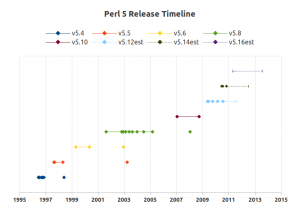My last post showed historical Perl 5 release cycles, but comments I got on and off the blog suggested that my vaguely positive sentiments about the official support policy were misunderstood. This post expands and clarifies my view.
I have redone my Perl 5 release cycle graph again with a few changes. First, for the v5.4 through v5.8 series, I have broken the line to the final release, which I consider to be “outliers”. I think the Perl community was lucky to get those releases — was lucky that someone stepped up and made them — and that they don’t reflect a “normal development” or support cycle.
Second, I have projected an estimated lifecycle under the official support policy for v5.12, v5.14 and the not-yet-released v5.16. This represents an expectation for the normal support lifetime of these releases and I think shows a better contrast of expectations resulting from the support policy introduced with v5.14 compared to historical releases.
click for larger view
My observations (ignoring outliers):
- Prior to v5.14, there was a (sometimes lengthy) gap between the end of one stable series and the start of the next.
- The actively maintained periods of v5.4, v5.5 and v5.6 were shorter than the proposed support windows under the new policy
- v5.8 had two different support paradigms. Between v5.8.0 and v5.8.1 was a long gap similar to the v5.6 series. v5.8.1 to v5.8.8 had a more regularly-spaced series of support releases.
- v5.10 had the longest gap between initial release (v5.10.0) and the subsequent support release (v5.10.1)
- v5.12 has had the most consistent pattern of support releases after the initial release, and is the only stable Perl 5 to have a (regular, not outlier) support release after the release of the next stable version
- v5.14 was the first stable Perl 5 released under the new annual-release cycle
The new support policy most resembles a return to the best support period seen historically (v5.8.1 to v5.8.8), but without the subsequent gap to the next stable release.
Why do I think this new policy is a positive step forward? Here are some reasons:
- The support policy is actually written down. What expectations did anyone have prior? I don’t know. But if I’m using Perl 5, I’d rather know what to expect that have to guess and hope for the best.
- The new policy offers a support window longer in practice than any Perl 5 except v5.8 and more regular than any period except between v5.8.1 and v5.8.8
- The new stable Perl 5 is available for migration testing mid-way through the support window of the prior stable release. If there are issues with migration, users can be confident of support for their existing version for an additional year (and emergency security support for a year after that).
- The annual release cycle means the change between one stable release and the next will be smaller, lowering migration risk
The new policy does cut off the “long tail” of expectations for an outlier release. I can understand that for some companies or OS packagers, a two-year support window (three for security) might feel too short, even if that is longer than was typically seen historically.
Here is where the annual stable release cycle and monthly development release cycle offer a huge side benefit: there is now a well-documented, frequently-used, regularly-updated release manager’s guide for Perl 5. Now, the release process is so easy that a moderately-skilled Perl software engineer without much prior exposure to the Perl source repository can make a Perl 5 release tarball in about a day.
This means that even if the core Perl 5 development team isn’t supporting, say, v5.12 anymore, a motivated company or community group could do the work necessary to prepare their own “outlier” release and either petition the Perl 5 core team to release it or could release their own stable “micro-fork” for others with long-term support needs. (There might even be a profitable business opportunity selling support for Perl versions past the official support window.)
Previously, Perl 5 development used to be bursty, with long delays between stable releases and with unclear expectations for support. Now, Perl 5 development happens like clockwork, and has a clear, written support policy.
[Note: this post represents my individual opinion and was not reviewed by the Perl 5 Porters core development team; it may or may not represent the views of other core developers; it is certainly not an “official” statement of the Perl 5 Porters in any way]
